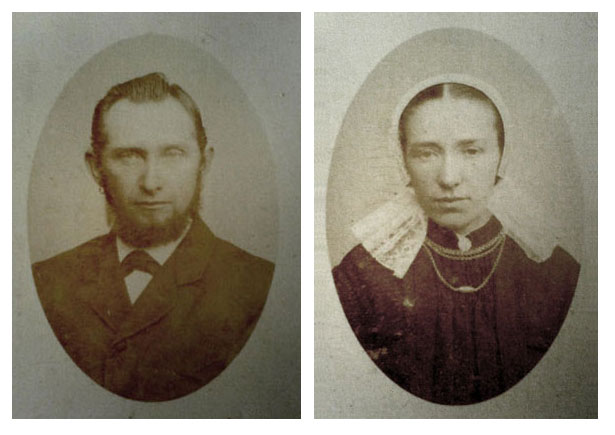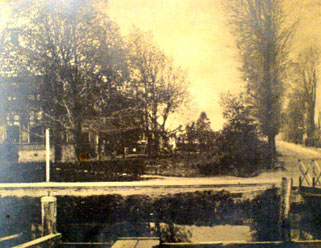 History
of the Drost family
History
of the Drost family
Dedemsvaart
Van Haeringen
Drost
![]() We can commence the history of Dedemsvaart by mentioning Mr. Gerrit
Willem van Marle, who was the mayor of Zwolle at
the end of the 18th century. He possessed extensive peat-grounds north of the
river Vecht in Overijssel. This area, originally consisting of so called "markegronden"
(communal ground where local peasants had the right of exploitation), was bought up by Van Marle, who spent great sums of his family
capital on it. He had the idea of digging a canal through the area and levelling the
peat. Due to the political circumstances of the time (Prussian occupation, French
Revolution), he couldn't carry out that plan during his life. He died in 1799.
We can commence the history of Dedemsvaart by mentioning Mr. Gerrit
Willem van Marle, who was the mayor of Zwolle at
the end of the 18th century. He possessed extensive peat-grounds north of the
river Vecht in Overijssel. This area, originally consisting of so called "markegronden"
(communal ground where local peasants had the right of exploitation), was bought up by Van Marle, who spent great sums of his family
capital on it. He had the idea of digging a canal through the area and levelling the
peat. Due to the political circumstances of the time (Prussian occupation, French
Revolution), he couldn't carry out that plan during his life. He died in 1799.
![]() Some
3 years after van Marle's death, his eldest daughter Judith married a nobleman
called Mr. Willem Jan Baron van Dedem tot den Berg en Rollecate. Besides
being a nobleman he also was a qualified lawyer, and possessed many acres of ground
in the North of Overijssel. By the marriage he inherited most of Van Marle's
posessions. Being an ambitious man, he proved to be a true successor of his
father-in-law. He had a chat with king Louis Napoleon about the canal project, and the
king was really interested. The digging work started in 1809.
By the end of the year there was a waterway from Hasselt to the inn at the Lichtmis.
Some
3 years after van Marle's death, his eldest daughter Judith married a nobleman
called Mr. Willem Jan Baron van Dedem tot den Berg en Rollecate. Besides
being a nobleman he also was a qualified lawyer, and possessed many acres of ground
in the North of Overijssel. By the marriage he inherited most of Van Marle's
posessions. Being an ambitious man, he proved to be a true successor of his
father-in-law. He had a chat with king Louis Napoleon about the canal project, and the
king was really interested. The digging work started in 1809.
By the end of the year there was a waterway from Hasselt to the inn at the Lichtmis.
![]() The
area north of the river Vecht consisting of those 'markelanden', was in
fact a large wasteland, by that time one of the last white spots on the
Dutch map. According to the reverend Senden, writing about it in 1830, the
area was so deserted, that even no sand trails were to be found there.
There was only bog, with peat-ridges and shallows here and there. The few people
ever seen there were illegal lumber-traders and poachers. For many years there was no social or demographic need for further exploitation,
until the beginning of the 19th century.
The
area north of the river Vecht consisting of those 'markelanden', was in
fact a large wasteland, by that time one of the last white spots on the
Dutch map. According to the reverend Senden, writing about it in 1830, the
area was so deserted, that even no sand trails were to be found there.
There was only bog, with peat-ridges and shallows here and there. The few people
ever seen there were illegal lumber-traders and poachers. For many years there was no social or demographic need for further exploitation,
until the beginning of the 19th century.
![]() When the
canal had been dug out to Balkbrug, labourers came for cutting the turf. These labourers were hobo's that had been
previously employed in the counties of Groningen, Friesland
and Drenthe. They built their homes from slices of peat during the night. If by
the morninglight smoke came out of a hole in the roof, they couldn't be expelled
by the landowner. These people lived under severe conditions. As a family they
worked for the 'veenbaas' (peat-boss). When they had to work on a new location, they
had to build a new home there.
When the
canal had been dug out to Balkbrug, labourers came for cutting the turf. These labourers were hobo's that had been
previously employed in the counties of Groningen, Friesland
and Drenthe. They built their homes from slices of peat during the night. If by
the morninglight smoke came out of a hole in the roof, they couldn't be expelled
by the landowner. These people lived under severe conditions. As a family they
worked for the 'veenbaas' (peat-boss). When they had to work on a new location, they
had to build a new home there.
 In the meantime Van
Dedem was continuing his canal project. He extended it to Sluis 6, and in 1817
he started digging a parallel canal where the settlement Dedemsvaart was being
founded. In the course of time the settlement generated more and more activity. But
as a commercial ship-canal the Dedemsvaart didn't turn out to be succesful,
which proved to be fatal for Van Dedem. He ran out of money and had to sell the
canal to the county to satisfy his creditors. After that, the job was soon
accompliced. About 1850 a connection to the Zwarte Water was made. East from the
town of Coevorden they made a shortcut to the river Vecht. But it wasn't a
change for the better, as far as the canal was concerned. The ships never
arrived. Nowadays the Dedemsvaart
for the main has been filled up again.
In the meantime Van
Dedem was continuing his canal project. He extended it to Sluis 6, and in 1817
he started digging a parallel canal where the settlement Dedemsvaart was being
founded. In the course of time the settlement generated more and more activity. But
as a commercial ship-canal the Dedemsvaart didn't turn out to be succesful,
which proved to be fatal for Van Dedem. He ran out of money and had to sell the
canal to the county to satisfy his creditors. After that, the job was soon
accompliced. About 1850 a connection to the Zwarte Water was made. East from the
town of Coevorden they made a shortcut to the river Vecht. But it wasn't a
change for the better, as far as the canal was concerned. The ships never
arrived. Nowadays the Dedemsvaart
for the main has been filled up again.
![]() The
construction of stone houses in the peat-colony Dedemsvaart (by that time
called "De Kolonie") started in 1820. Stones
were supplied by ship, just like the shells that were processed to cement
in limekilns on the spot. Besides many dwellings, some shops and pubs were
built. It is in that same year 1820 that the first church, a Roman
Catholic one, opened its doors. A Dutch Reformed church (Nederlands
Hervormd) was erected in 1834.
The
construction of stone houses in the peat-colony Dedemsvaart (by that time
called "De Kolonie") started in 1820. Stones
were supplied by ship, just like the shells that were processed to cement
in limekilns on the spot. Besides many dwellings, some shops and pubs were
built. It is in that same year 1820 that the first church, a Roman
Catholic one, opened its doors. A Dutch Reformed church (Nederlands
Hervormd) was erected in 1834.
![]() Religious life was very important by then. In 1832
the Ulrum clergyman H. de
Cock had separated from the Dutch Reformed
Church, to found a new Reformed church of his own ("Gereformeerde" kerk).
Many people also adhered to this creed in Dedemsvaart. One of their
sympathisers was the peat-boss Hein van Haeringen. His name is to be found
in a list of people who signed a letter in favour of De Cock's ideas. In 1842 a
wooden building was erected where the Seperated Reformed could hold their
services. One year after that they got their own pastor. (The
history of the Gereformeerde Kerk of Dedemsvaart is lavishly documented on
their own website).
Religious life was very important by then. In 1832
the Ulrum clergyman H. de
Cock had separated from the Dutch Reformed
Church, to found a new Reformed church of his own ("Gereformeerde" kerk).
Many people also adhered to this creed in Dedemsvaart. One of their
sympathisers was the peat-boss Hein van Haeringen. His name is to be found
in a list of people who signed a letter in favour of De Cock's ideas. In 1842 a
wooden building was erected where the Seperated Reformed could hold their
services. One year after that they got their own pastor. (The
history of the Gereformeerde Kerk of Dedemsvaart is lavishly documented on
their own website).
![]() In
1702 Jacobus van Heeringh was born in Leiden. He married Josijntje de Jong.
In 1726 their son kregen ze een zoon, Hendrik
Jacobse
van Heeringh was born. His grandson Henry (Hendrik van Haeringen) was born in Nieuwkoop (close
to Alphen a/d Rijn) on the 26th of july 1793. By that time they were engaged in
cutting turf there. Also Henry made a living out of that. At the age of 20
he married Klazina Stolk and became the head of a quickly growing
family. But in the twenties of the 19th century turf became exhausted in the
west of Holland, and in 1829 Henry removed with his family to the
Colony at the Dedemsvaart. For ten years he lived there with his family in
a turf hut. Little by little, by working hard, and with the help of his
children, he managed to improve the situation. By the time he was 50
years old, he didn't need to work for other people any longer. He was able
Instead of
that, he could buy his own acres of peat-ground and cut the turf. Thus the
legend of Hernry boss (Heinbaas, as they used to call him then) was born.
The turfhut was changed for a wooden house and later on for a farm. The
levelled grounds (dalgronden) were brought to cultivation, first for
simple stock-breeding (a goat they had already) and later on for
agriculture. Henry had worked himself up from a labourer to a landowner.
In
1702 Jacobus van Heeringh was born in Leiden. He married Josijntje de Jong.
In 1726 their son kregen ze een zoon, Hendrik
Jacobse
van Heeringh was born. His grandson Henry (Hendrik van Haeringen) was born in Nieuwkoop (close
to Alphen a/d Rijn) on the 26th of july 1793. By that time they were engaged in
cutting turf there. Also Henry made a living out of that. At the age of 20
he married Klazina Stolk and became the head of a quickly growing
family. But in the twenties of the 19th century turf became exhausted in the
west of Holland, and in 1829 Henry removed with his family to the
Colony at the Dedemsvaart. For ten years he lived there with his family in
a turf hut. Little by little, by working hard, and with the help of his
children, he managed to improve the situation. By the time he was 50
years old, he didn't need to work for other people any longer. He was able
Instead of
that, he could buy his own acres of peat-ground and cut the turf. Thus the
legend of Hernry boss (Heinbaas, as they used to call him then) was born.
The turfhut was changed for a wooden house and later on for a farm. The
levelled grounds (dalgronden) were brought to cultivation, first for
simple stock-breeding (a goat they had already) and later on for
agriculture. Henry had worked himself up from a labourer to a landowner.
![]() The
Van Haeringens were peaterers till the beginning of the 20th century. In the course of time they
proved to be progressive and
unconventional farmers. As far as I know,
our family decends from one of Henry's sons, Arie (born 1826 at
Waveren). Arie married twice, first to Catharina Koster and then to Anna Hendrika de
Vries. From the first marriage another Henry was born. Because of the big beard he grew
in later years, they used to call him Bearded Henry (Baardhein). He
lived at his father's farm, on the corner of the Stroomwijk, the fist
side-channel above Sluis 6. For a long time he was an alderman for the
district of Avereest. The decoration you see on this page, is an eardrop Henry
must have had in his ear. He marries Willemina Rooseboom, daughter of Jacominus Arnoldus
Rooseboom and Anna Hendrika
van der Heide. He is the father of Cathrine van Haeringen (March 9 1888 -
February 25 1971), our Grandma. From the legacy of Grandma's sister Anna I
got this eardrop.
The
Van Haeringens were peaterers till the beginning of the 20th century. In the course of time they
proved to be progressive and
unconventional farmers. As far as I know,
our family decends from one of Henry's sons, Arie (born 1826 at
Waveren). Arie married twice, first to Catharina Koster and then to Anna Hendrika de
Vries. From the first marriage another Henry was born. Because of the big beard he grew
in later years, they used to call him Bearded Henry (Baardhein). He
lived at his father's farm, on the corner of the Stroomwijk, the fist
side-channel above Sluis 6. For a long time he was an alderman for the
district of Avereest. The decoration you see on this page, is an eardrop Henry
must have had in his ear. He marries Willemina Rooseboom, daughter of Jacominus Arnoldus
Rooseboom and Anna Hendrika
van der Heide. He is the father of Cathrine van Haeringen (March 9 1888 -
February 25 1971), our Grandma. From the legacy of Grandma's sister Anna I
got this eardrop.
|
|
|
| Hendrik van Haeringen (Sept. 19 1859 - June 3 1936). On May 20 1887 he married Willemina Rooseboom (Okt. 29 1863 - Oct. 6 1932). On the photograph, the earring is evidently visible. I don't know if the wearing of such an ornament by males was customary at thar time. Maybe he was just a little bit excentrical. | |
|
|
|
| Johanna Hendrika van der Heide (1833-1916),
married to Jacominus Arnoldus Roosenboom, baker at Dedemsvaart. www.genealogieonline.nl
For more information see also Appendix II
|
Catharina van Haeringen, her
granddaughter. She was the eldest from a family of 10 children. For more
details about it see also the genealogical site of m.c.vermaat
Of het funeral is still existing a sound recording on tape (in my posession).
|
![]() In general, the Van Haeringens are intelligent and creative, and according to my
mother they have a spiritual inclination. The family knows musicians, scientists,
clergymen, and inventors. One of Grandma's brothers, Gerrit
van Haeringen, developped some potato races which did well on the levelled
peat-grounds. One of them was called the Deva (abreviation of
Dedemsvaart), another one with the fair name IJsselster. A third
species, the Patrones, has been tried out by the Dutch Ministery of
Agriculture at different areas in the world, among which Africa. With poor results, after all. Gerrit had
a farm at the 16e Wijk, naming it after his mother: Willeminahoeve. Simon Drost
Hermansn now lives
on
that farm with his family. It is here that
the Dutch family reunion (June 14 2003) was held.
In general, the Van Haeringens are intelligent and creative, and according to my
mother they have a spiritual inclination. The family knows musicians, scientists,
clergymen, and inventors. One of Grandma's brothers, Gerrit
van Haeringen, developped some potato races which did well on the levelled
peat-grounds. One of them was called the Deva (abreviation of
Dedemsvaart), another one with the fair name IJsselster. A third
species, the Patrones, has been tried out by the Dutch Ministery of
Agriculture at different areas in the world, among which Africa. With poor results, after all. Gerrit had
a farm at the 16e Wijk, naming it after his mother: Willeminahoeve. Simon Drost
Hermansn now lives
on
that farm with his family. It is here that
the Dutch family reunion (June 14 2003) was held.
Below a photograph from 1927 at the 40-years jubilee of Hendrik van Haeringen. Members of the families Drost and Van Haeringen. Click on the photograph for a bigger image.
|
|
|
|
The great-grandparents Jan Drost and Jantje Swartwold. Photograph probably somewhere around 1920. This pictuere and other information from the "Genealogie Familie Prins" (1993) |
Jan Drost's farm at Dedemsvaart. On this site, Later on, two new houses were constucted, Swartwoltstee, and 't Hoekje, where our grannies spent there old day. Also see Appendix I below. |
![]() The
history of the Drost family starts at Wildervank with Hendrik Simons Drost.
Despite extensive historical research it is not known where this this
Henry came from. But it should be noted that the name Drost is also
common in Germany. The first known fact dates from 1742. Henry signed a
"Sealing" in the prescence of the pastor at Wildervank. It is assumed he
possessed some ground over there.
The
history of the Drost family starts at Wildervank with Hendrik Simons Drost.
Despite extensive historical research it is not known where this this
Henry came from. But it should be noted that the name Drost is also
common in Germany. The first known fact dates from 1742. Henry signed a
"Sealing" in the prescence of the pastor at Wildervank. It is assumed he
possessed some ground over there.

![]() In 1764 Hendrik Simons Drost
marries Trijntje Jans Prummel. From this marriage Simon Hendriks Drost is born
(1766-1830). He marries Derkien Jans in 1794. Out of that marriage Jan Simons Drost
is born (March 3 1803- Feb 26 1891). He marries Eiltje de Wit (May 24 1809-
March 26 .1900).
They have a son Simon Drost
(ca 1840- Feb 17 1867) who marries Ida Prins (July 2 1840- April 3 1878). From
this marriage Jan Drost is born (June 18 1864- Jan 24.1934). This is the Jan of
the picture above. Little John has a tough youth. His father Simon drowns in a
lake, Het Laardermeer. From the age of 13 he is an orphan. As far as we
know he goes pretty well later on. First he's a farmer at Veendam and
Wildervank, and from 1897 at Dedemsvaart (Het Hoekje). Jan Drost married
three times. The first time with a woman whose family name is Smeenk. From
the second marriage, with Jantje Swartwold, comes forth the family in
which Simon (our Grandpa Drost, July 5 1891 - Nov 18) is the eldest son. The third
marriage is with his niece Aaltje
Mulder.
In 1764 Hendrik Simons Drost
marries Trijntje Jans Prummel. From this marriage Simon Hendriks Drost is born
(1766-1830). He marries Derkien Jans in 1794. Out of that marriage Jan Simons Drost
is born (March 3 1803- Feb 26 1891). He marries Eiltje de Wit (May 24 1809-
March 26 .1900).
They have a son Simon Drost
(ca 1840- Feb 17 1867) who marries Ida Prins (July 2 1840- April 3 1878). From
this marriage Jan Drost is born (June 18 1864- Jan 24.1934). This is the Jan of
the picture above. Little John has a tough youth. His father Simon drowns in a
lake, Het Laardermeer. From the age of 13 he is an orphan. As far as we
know he goes pretty well later on. First he's a farmer at Veendam and
Wildervank, and from 1897 at Dedemsvaart (Het Hoekje). Jan Drost married
three times. The first time with a woman whose family name is Smeenk. From
the second marriage, with Jantje Swartwold, comes forth the family in
which Simon (our Grandpa Drost, July 5 1891 - Nov 18) is the eldest son. The third
marriage is with his niece Aaltje
Mulder.
![]() March 4 1915 Simon Drost
marries Catherina van Haeringen (March 9 1888 - Feb 25 1971) and rents a farm at
Lutten. At this farm the
first children are born. In these years, there still is a raiway
connection between Lutten and Dedemsvaart, and there's a lot of travelling to
and fro. After some years, when Simon has to fulfill his military obligations,
the family moves into an temporary house at Dedemsvaart. In the early twenties
they buy a farm from the family Stuut at the 16e Wijk. That
farm was constructed somewhere about 1917. Like many "Groninger" farms from that
time it's a construction of a poor quality. But it's a large building and has a
lot of advantages. The family gradually extends to 13 children and 2 parents.
Life is not always easy. Especially the crisis, starting at 1929, is hard on
them. The war threat and the Nazi-occupation, following shortly after, is even
worse. Sometimes the labourers can't even get paid, and for compensation they
get concessions to dig off the remaining turf dykes. Also, certain childeren had
serious health problems. The eldest son Jan isn't able to succeed his father at
the farm, because of his leg problems. Riek is born with an underdeveloped hip.
The war casts a darker shadow over their existence. Son Henk joins the
resistance movement (called "terrorrism" by the germans) and gets
executed just before the liberation. Father Simon chooses to stay loyal to his
morals and believes. After the war he takes german orphans in his house.
March 4 1915 Simon Drost
marries Catherina van Haeringen (March 9 1888 - Feb 25 1971) and rents a farm at
Lutten. At this farm the
first children are born. In these years, there still is a raiway
connection between Lutten and Dedemsvaart, and there's a lot of travelling to
and fro. After some years, when Simon has to fulfill his military obligations,
the family moves into an temporary house at Dedemsvaart. In the early twenties
they buy a farm from the family Stuut at the 16e Wijk. That
farm was constructed somewhere about 1917. Like many "Groninger" farms from that
time it's a construction of a poor quality. But it's a large building and has a
lot of advantages. The family gradually extends to 13 children and 2 parents.
Life is not always easy. Especially the crisis, starting at 1929, is hard on
them. The war threat and the Nazi-occupation, following shortly after, is even
worse. Sometimes the labourers can't even get paid, and for compensation they
get concessions to dig off the remaining turf dykes. Also, certain childeren had
serious health problems. The eldest son Jan isn't able to succeed his father at
the farm, because of his leg problems. Riek is born with an underdeveloped hip.
The war casts a darker shadow over their existence. Son Henk joins the
resistance movement (called "terrorrism" by the germans) and gets
executed just before the liberation. Father Simon chooses to stay loyal to his
morals and believes. After the war he takes german orphans in his house.
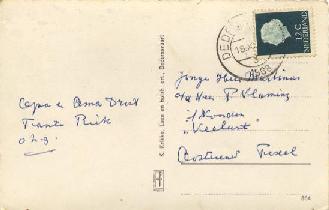
![]() In the following years several family members emmigrate to Canada.Simons'
brother Herman goes over there, and also 2 of his own sons, Arie en Ralph. In
1959 his own son Herman takes over the farm at the 16e Wijk. Next to Herman, his
brother Arnold gets his own farm. Simon and Catharina go and live at 't Hoekje in
Dedemsvaart. At 't Hoekje in 1961, the tape is recorded wich can be heard
on this website. The tape has been responded from Canada (go to the page sound).
During those years Simon has a complaint that makes him speak rather nasally (his
father Jan seems to have had it as well). Later he gets cataract, with the
result of him becoming almost blind. On November 18, 1968, he dies very sudden.
I shall always remeber that, because my birthday is on November 17. When the
congratulations postcard for me ("Jonge Heer Martinus") arrived, he just had died. Catharina stays behind, but in
1973, she also passes away.
In the following years several family members emmigrate to Canada.Simons'
brother Herman goes over there, and also 2 of his own sons, Arie en Ralph. In
1959 his own son Herman takes over the farm at the 16e Wijk. Next to Herman, his
brother Arnold gets his own farm. Simon and Catharina go and live at 't Hoekje in
Dedemsvaart. At 't Hoekje in 1961, the tape is recorded wich can be heard
on this website. The tape has been responded from Canada (go to the page sound).
During those years Simon has a complaint that makes him speak rather nasally (his
father Jan seems to have had it as well). Later he gets cataract, with the
result of him becoming almost blind. On November 18, 1968, he dies very sudden.
I shall always remeber that, because my birthday is on November 17. When the
congratulations postcard for me ("Jonge Heer Martinus") arrived, he just had died. Catharina stays behind, but in
1973, she also passes away.
![]() After that,
the farm at the 16e Wijk will not be in the a family posession for a long time
anymore. When son Herman dies in 1982, it passes along to the
family Wilbrink from Apeldoorn. They make a goat farm out of it, and that's what
it is untill the present day. The further viscissitudes of the family
members is, as far as it is been permitted or documented, to be found under the
buttons left and above.
After that,
the farm at the 16e Wijk will not be in the a family posession for a long time
anymore. When son Herman dies in 1982, it passes along to the
family Wilbrink from Apeldoorn. They make a goat farm out of it, and that's what
it is untill the present day. The further viscissitudes of the family
members is, as far as it is been permitted or documented, to be found under the
buttons left and above.
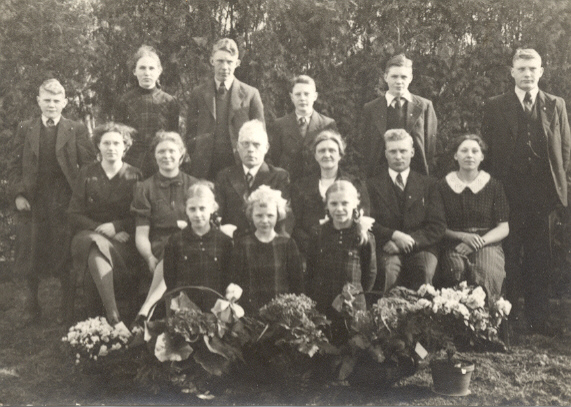
Rear: Arie, Jeanette, Henk, Roelof, Arnold, Herman
Middle: Riek, Mien, Opa, Oma, Jan, Jantje
Front: Ida, Rolina, Anna
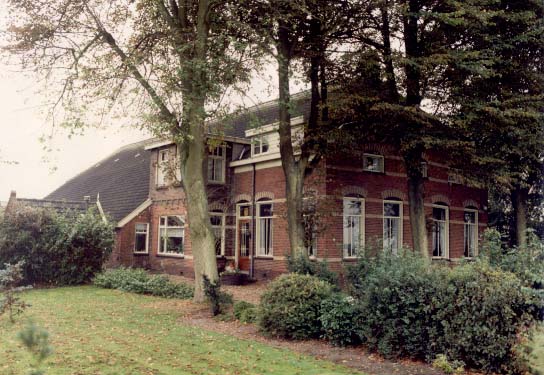
The family-farm at the 16e Wijk (picture taken later)
Appendix I ( by Henk Drost Arnoldson) - 2004
About the history Van Haeringen, Hendrik (Heinbaas) first lived in Dedemsvaart in a sod house. When he got a peaterer himself, he built a wooden house, because on that spot the soil was not though enough for a stone building. Later on het constructed a large stone building at the Truiswijk, round 1854. There he controlled a lift-bridge, together with the family Minke. After Heinbaas' death his son Gerrit inherited the farm. This farm is still there.
About the Drost-family. Jan Drost had a farm at the Nieuwe Weg (later it was called the Wethouder van Haeringenstraat, named after Baardhein). Later he pulled down this farm to build two dwelling houses over there: "'t Hoekje" and the "Swartwoldstee". These houses still are there
Appendix II ( by Wim van Haeringen, son of Arie van Haeringen) - 2005
The parents of Willemina Rooseboom are called Jacominus Arnoldus Rooseboom & Johanna Hendrika van der Heide. Jacominus Arnoldus comes from Elburg; he first married Wolterdina Veeneman. Johanna Hendrika is his second wife. When she was married, she was 19 years old. Right from the start, she had the care of the 4 children of her husband. She herself gave birth to 7 more children, among them Willemina Rooseboom. Johanna Hendrika's parents were called Meine van der Heide & Elisabeth Geraets. Elisabeth was baptised as a Roman Catholic in Dordrecht. Meine first had a job in Veenhuizen, a kind of warden in an institute. There he met Elisabeth. It was a forced marriage. Later Meine & Elisabeth worked in Ommerschans, exactly on the same farm where Lieuwe Hiemstra & Jantje Drost lived. Your aunt Jantje Drost knows more about that, I understood from A. A. van der Heide (a Canadian family-member, with whom I do exchange genealogical information).
Appendix III ( by Jaap Westerink) - 2007
On the address list there's a certain P.Drost from Germany to be found. That's Dicky and her husband. Dicky is the only living daughter from the first marriage of uncle Herman from Canada, and she was married to someone, on the condition that he would change his surname to Drost, because she wanted to keep the name Drost. Officially she does not belong on this site as a son/daughter of Simon and Cathrine (grandpa and grandma). I think she came on this list by accident when I made it at that time. She is in my database in case my mother would come to die, so that we can send her a message.
